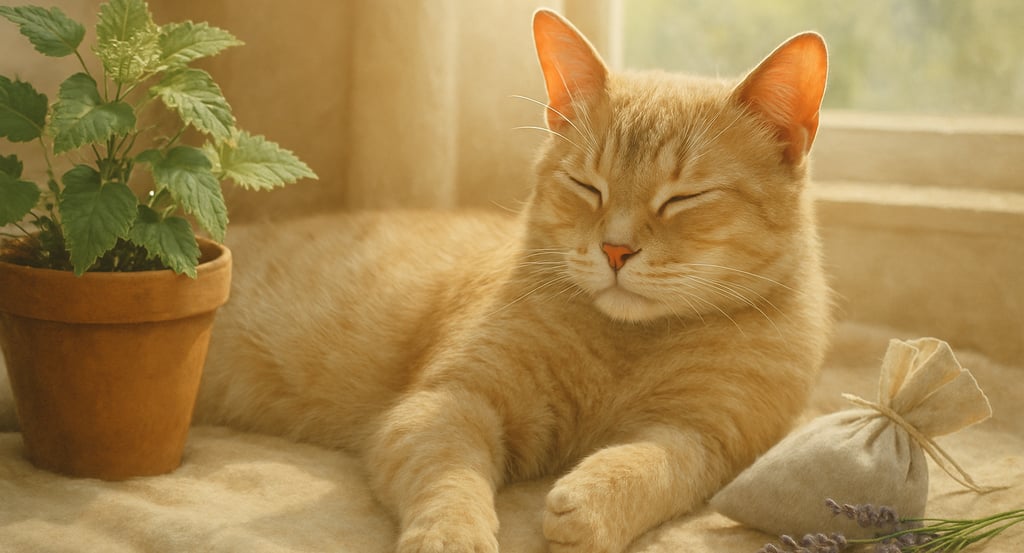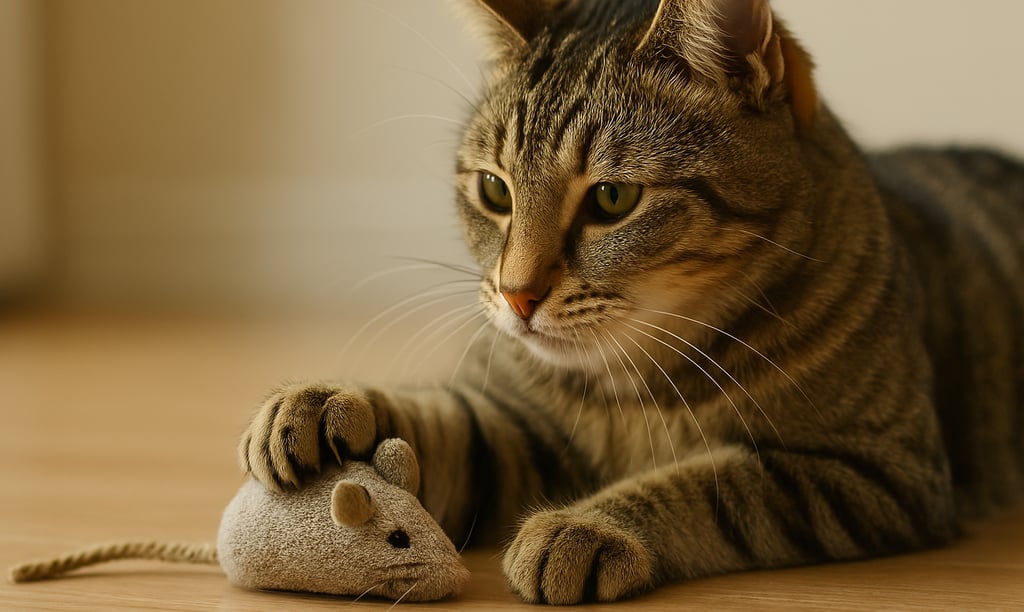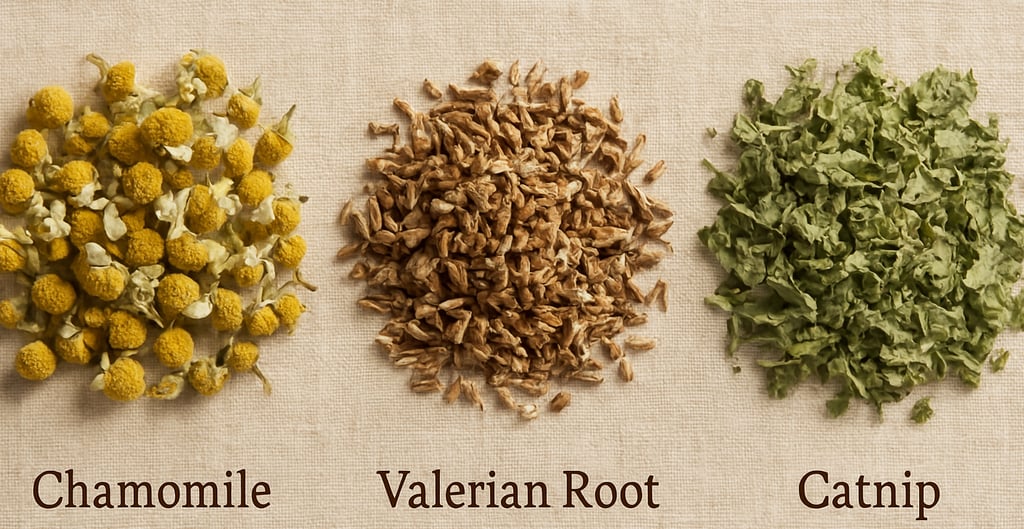5 Calming Herbs for Anxious Cats (And How to Use Them Safely)
PROACTIVE & NATURAL FELINE WELLNESS


Our feline companions, much like us, can experience anxiety and stress. Changes in routine, new environments, loud noises, or even underlying health issues can trigger anxious behaviors in cats, such as hiding, excessive grooming, changes in appetite, or aggression. While veterinary consultation is crucial to rule out medical causes and for severe anxiety, certain calming herbs can offer gentle, natural support for mildly anxious cats. It's vital to use these herbs correctly and safely, always prioritizing your cat's well-being. This article explores five common calming herbs for cats and provides guidance on their safe application.
Understanding Feline Anxiety
Before introducing any remedies, it's helpful to recognize signs of anxiety in cats. These can be subtle and may include:
Behavioral Changes: Increased hiding, withdrawal from social interaction, or uncharacteristic aggression.
Vocalization: Excessive meowing, yowling, or hissing.
Grooming Habits: Over-grooming, leading to bald patches or skin irritation.
Litter Box Issues: Inappropriate urination or defecation outside the litter box.
Appetite Changes: Decreased or increased appetite.
Restlessness: Pacing or inability to settle down.
If you notice these signs, a vet visit is the first step to ensure there isn't a medical reason for the behavior. Once medical issues are ruled out, and if the anxiety is mild, natural herbs can be considered as part of a holistic approach to calming your cat.
Five Calming Herbs for Cats
It is crucial to remember that not all herbs safe for humans are safe for cats, and dosages will be significantly different. Always consult with a holistic veterinarian before introducing any new herb to your cat’s routine, especially if your cat has pre-existing health conditions or is on medication.
Catnip (Nepeta cataria):
How it Works: While often known for its stimulating effects in about 50-70% of cats (due to the nepetalactone compound), for some cats, particularly after the initial excitement wears off, catnip can have a calming and relaxing effect. The initial playful burst can help release pent-up energy, leading to a more serene state afterward. For cats that don't react with excitement, it may induce calmness directly.
Safe Use: Offer a small pinch of dried catnip or a fresh leaf. You can sprinkle it on a scratching post, toy, or a designated play area. Observe your cat’s reaction. If it causes overstimulation or aggression, discontinue use. Use sparingly, as frequent exposure can diminish its effects.
Valerian Root (Valeriana officinalis):
How it Works: Similar to catnip for some cats, valerian can initially cause excitement followed by a period of calmness and sleepiness. The scent is potent and attractive to many cats. It's thought to increase GABA (gamma-aminobutyric acid) in the brain, which has a calming effect.
Safe Use: Use dried valerian root. A small pinch can be put inside a sturdy toy or a "valerian pillow." Due to its potency, introduce it in very small amounts and observe your cat. Not all cats enjoy valerian; some may become hyperactive or even aggressive. Avoid using it with kittens or pregnant cats.
Chamomile (Matricaria chamomilla or Chamaemelum nobile):
How it Works: Chamomile is well-known for its gentle calming properties in humans and can have a similar mild sedative effect on cats. It can help soothe anxiety and promote relaxation.
Safe Use: A weak, cooled chamomile tea (unsweetened) can be offered in very small amounts (a teaspoon) or added to their water (if they accept it). Alternatively, a few drops of a diluted, cat-safe chamomile hydrosol (not essential oil) can be sprayed on their bedding. Ensure it's Matricaria chamomilla (German chamomile) or Chamaemelum nobile (Roman chamomile) and not other varieties. Avoid if your cat has ragweed allergies.
Lavender (Lavandula angustifolia):
How it Works: The scent of true lavender (Lavandula angustifolia) can be calming for some cats, promoting relaxation. However, lavender essential oil is toxic if ingested and can be irritating even when diffused if not done with extreme caution and proper dilution, far from the cat.
Safe Use: The safest way to use lavender is by using dried lavender flowers. Place a small sachet of dried lavender near your cat’s resting area, but ensure they cannot ingest the flowers. Alternatively, a very diluted, cat-safe lavender hydrosol can be lightly spritzed on bedding from a distance. Never apply essential oils directly to your cat or allow them to lick it. If using any form of lavender, monitor for any signs of lethargy, nausea, or skin irritation. Many vets advise against using lavender with cats due to toxicity concerns with essential oils, so dried flowers or hydrosols must be used with extreme caution and preference given to other herbs.
Silver Vine (Actinidia polygama):
How it Works: Silver vine is a plant native to Asia and is known to elicit a euphoric response in cats, often more intense and affecting a higher percentage of cats than catnip (including those who don't respond to catnip). The effects are similar: initial playfulness, rolling, and rubbing, followed by relaxation.
Safe Use: Offer powdered silver vine fruit galls or dried leaves/stems. It can be sprinkled on toys or scratching posts. As with catnip, use in moderation and observe your cat's reaction.
Important Considerations for Using Herbs
Consult Your Vet: This cannot be stressed enough. Always discuss with a veterinarian, preferably one with holistic experience, before using any herbal remedies.
Quality and Source: Use high-quality, organic herbs from reputable sources to avoid pesticides or contaminants.
Dosage: "More" is not better. Start with very small amounts to see how your cat reacts. Cat dosages are tiny compared to human dosages.
Individual Reactions: Just like humans, cats will react differently to herbs. What works for one cat might not work for another, or could even cause an adverse reaction.
Monitor Closely: Watch for any signs of adverse effects, such as vomiting, diarrhea, lethargy, or skin irritation. Discontinue use immediately if you notice any problems.
Not a Replacement for Behavioral Training or Medical Treatment: Herbs can be a supportive measure but are not a cure-all for anxiety, especially if it's severe or rooted in deep behavioral issues or medical conditions. They should be part of a broader plan that might include environmental enrichment, behavioral modification, and veterinary care.
Avoid Essential Oils (Generally): Most essential oils are highly concentrated and can be toxic to cats, whether ingested, inhaled, or absorbed through the skin, due to their sensitive metabolism and inability to process certain compounds. Hydrosols (floral waters) are a much safer, diluted alternative if considering aromatic use.
Creating a Holistic Calm Environment
Beyond herbs, remember that a cat's environment plays a huge role in their stress levels. Ensure your cat has:
Safe hiding spots.
Vertical space (cat trees, shelves).
Regular playtime and mental stimulation.
Consistent routines.
Clean litter boxes in accessible, private locations.
Access to fresh water and appropriate food.
By combining a supportive, enriched environment with the careful and informed use of calming herbs (under veterinary guidance), you can help your anxious feline find more peace and relaxation in their daily life.
CTA Teaser: Explore a wider range of natural remedies and holistic strategies for common feline issues, including anxiety and stress, in our comprehensive Holistic Cat Health guide. Learn how to create a truly nurturing environment for your thriving feline!ng!




Sustainable Cat Care
At EcoCatCare, we provide resources that help cat parents discover how sustainable choices can create healthier, happier lives for their feline companions while contributing to a healthier planet.
EcoCatCare © 2025. All rights reserved
